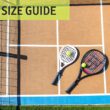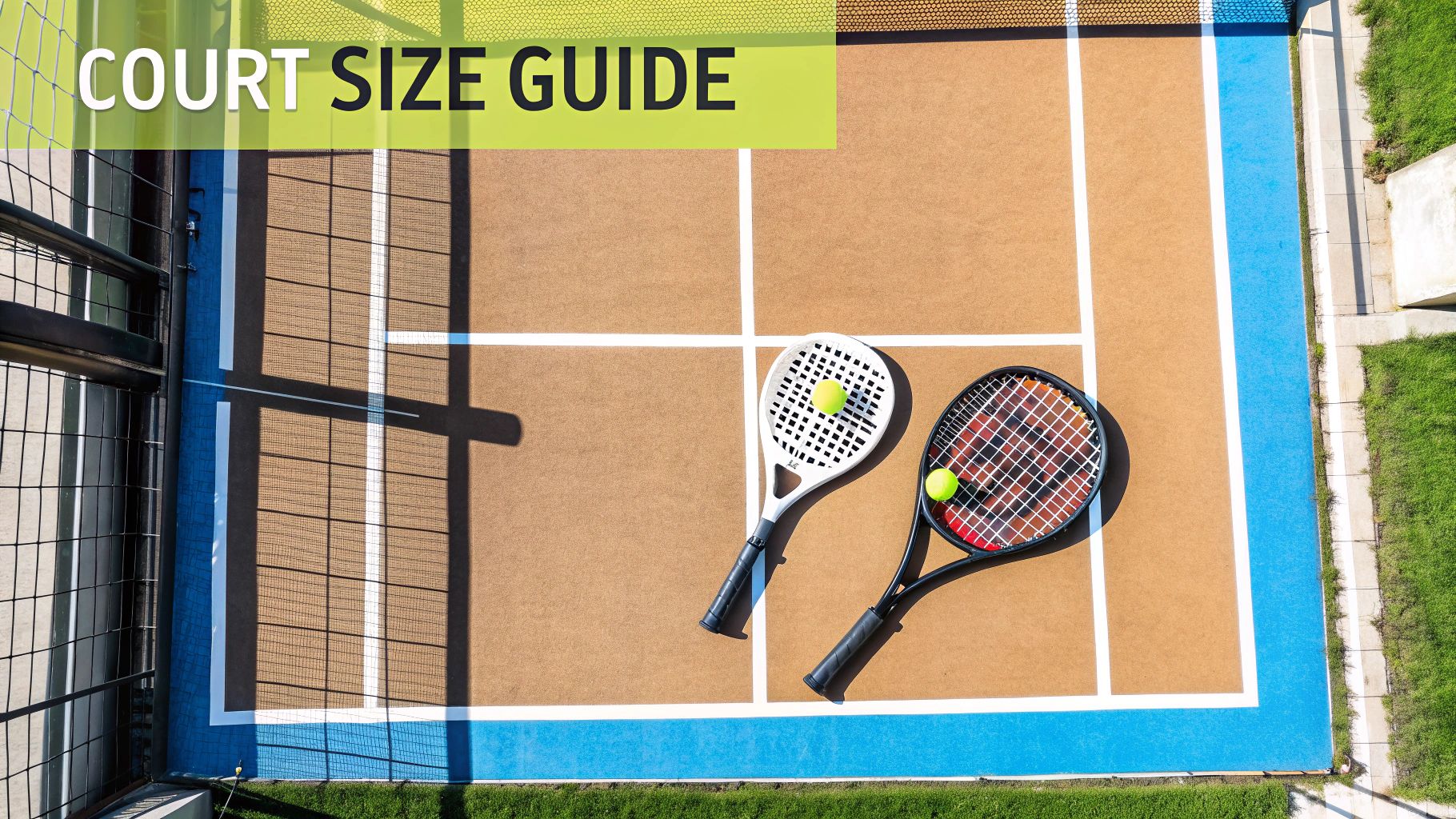At its core, a paddle ball court is a simple rectangle measuring 20 meters long by 10 meters wide. This compact playing area, roughly one-third the size of a tennis court, is where all the action happens. But what truly defines padel is that the court is enclosed by glass and mesh walls, which are very much an active part of the game.
Deconstructing the Official Padel Court Dimensions
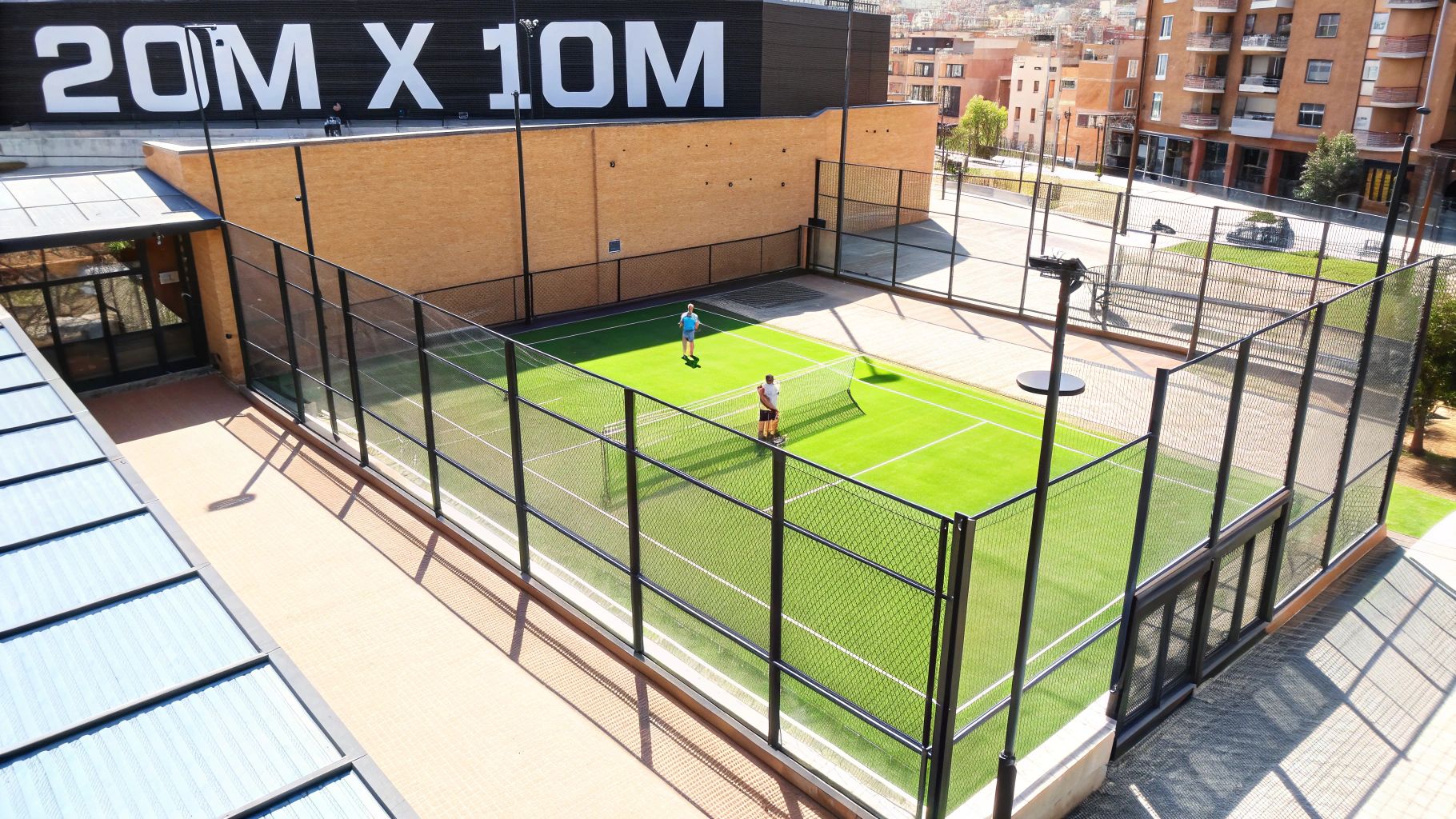
To really get a feel for the game's unique flow, you have to understand the standard paddle ball court size. It’s best to think of the court not just as a playing surface, but as a complete system built for fast, strategic rallies. Every single measurement is intentional, creating an environment that cleverly mixes elements of tennis and squash into something completely new.
The governing body, the International Padel Federation (FIP), is the one that sets the global standard for these dimensions. A regulation court must be exactly 20 meters (65.6 feet) long and 10 meters (32.8 feet) wide. This creates a total playing area of 200 square meters. Having a standardized size means you get a consistent experience, whether you're playing a casual match in Madrid or a tournament in Miami.

Buy the best padel gear to level up your next game!
CHECK OUT this deal from Padel Market!Get ready to take your game to the next level with the latest padel gear from Padel Market! Fast EU and Worldwide Shipping
For those curious about the nuts and bolts of putting one of these courts together, there's a great ultimate guide from morsportsgroup.com that dives deep into the construction process.
Padel Court Dimensions at a Glance
For a quick reference, here are the essential measurements broken down into both metric and imperial units. It’s always handy to have these numbers in your back pocket.
| Measurement | Metric (Meters) | Imperial (Feet) |
|---|---|---|
| Total Length | 20 m | 65.6 ft |
| Total Width | 10 m | 32.8 ft |
| Net Height (Center) | 0.88 m | 2.89 ft (34.6 in) |
| Net Height (Posts) | 0.92 m | 3.02 ft (36.2 in) |
These figures are the blueprint for every official padel court worldwide, ensuring fair play and a predictable environment for players at all levels.
How the Court's Size Shapes the Game
The dimensions of the court directly impact how the game is played. That smaller footprint forces quick reflexes and tight teamwork, which is a big reason why doubles is the sport's most common format.
Here’s a quick rundown of the main elements:
- Total Length: 20 meters from the back wall on one side to the back wall on the other.
- Total Width: 10 meters from one side wall to the opposite side.
- Net Height: The net is a bit lower than in tennis, standing at 0.88 meters (34.6 inches) in the center and rising to 0.92 meters (36.2 inches) at the posts.
This precise geometry is exactly what makes padel so inviting for new players. The enclosed space keeps the ball in play much longer, leading to incredible rallies and making it way easier for beginners to get the hang of it quickly.
These fundamental measurements really are the foundation the entire sport is built on. If you want to keep up with the latest news and information about padel courts, you might want to check out our other articles on the subject.
Deconstructing The Padel Court Layout and Markings
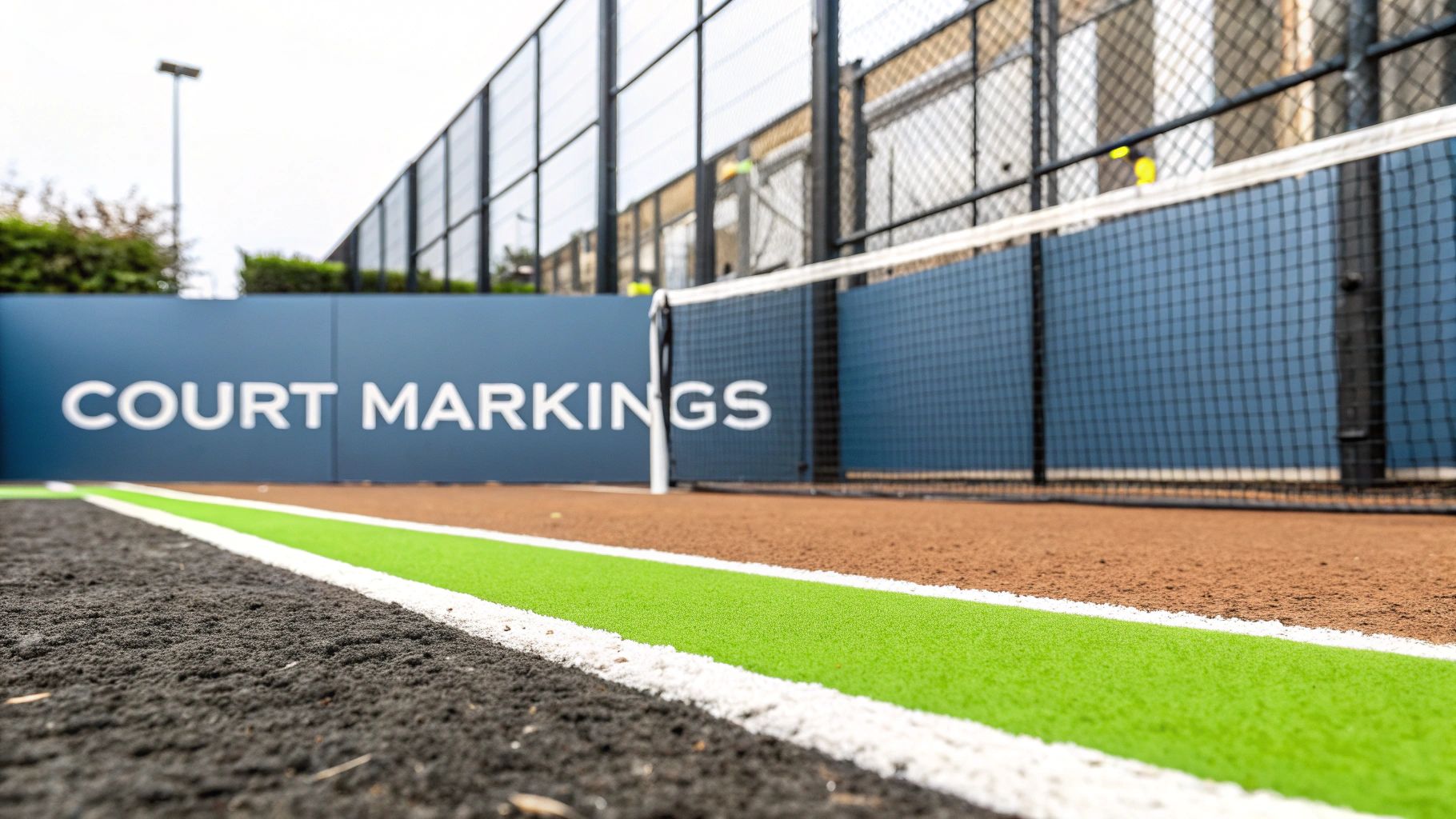
When you first step onto a padel court, you see more than just a 20×10 meter box. You see a grid of lines that dictates the entire game. Think of these markings as the rules of engagement, turning an empty rectangle into a dynamic arena for every serve, volley, and smash. They aren't just for show; they define boundaries, guide serves, and keep every match fair and consistent.
Getting a feel for this layout is your first real step toward mastering court positioning. The court is split perfectly in half by the net, giving each team their own territory. On each side, a service line runs parallel to the net, setting the back limit for a legal serve. This line isn’t just an eyeball measurement; its exact placement is crucial to the game.
The Anatomy of the Service Box
The zone between the net and that service line is where every single point kicks off. But it’s not just one big open space—it’s divided by another critical marking.
A central service line shoots out from the middle of the net straight back to the service line. This splits the area into two equal rectangles, which we all know as the service boxes. To start a point, you have to serve the ball into the service box that’s diagonally opposite you. This simple rule creates a precise target and adds a real layer of skill to the game’s opening shot.
So, how far is that service line from the net? According to the official rulebook, it sits exactly 6.95 meters back. And to make sure every line is easy to see, they all have to be 5 cm wide and painted in a color that pops against the court surface. No more arguments about whether a serve was in or out. If you want to dive deeper into the nitty-gritty of court construction, this BNL Italy Major Premier Padel guide is a great resource.
Key Takeaway: The layout isn't just for looks. The exact placement of each line directly influences serving strategy and rally dynamics, rewarding players who understand how to use the court's geometry to their advantage.
Ultimately, it’s the combination of these few lines—the two service lines and the central divider—that creates the foundation for every padel match. They might seem simple, but these markings are the secret sauce behind the strategic flow that makes the sport so addictive.
Where the Walls Become Part of the Game
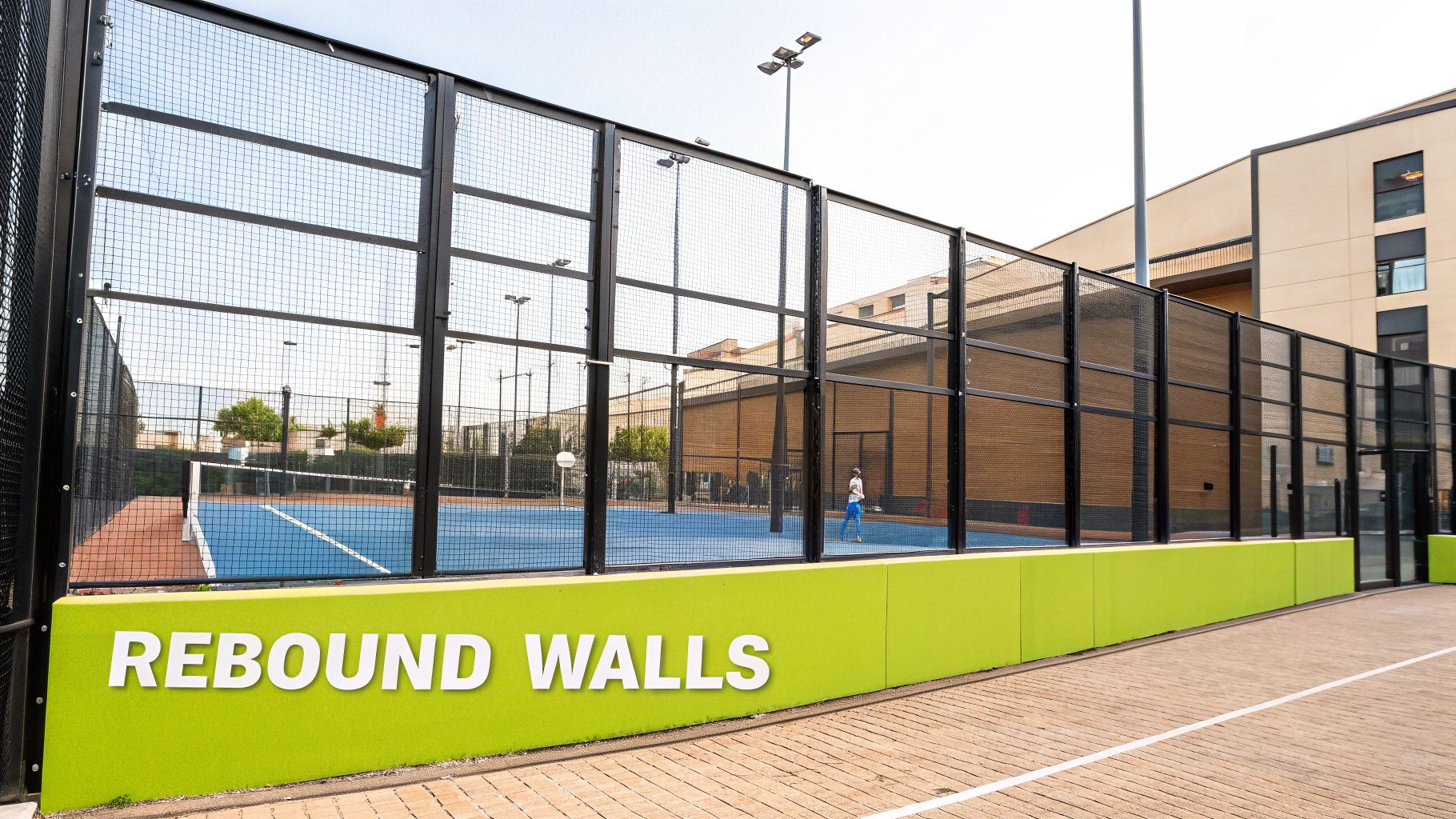

Buy the best padel gear to level up your next game!
CHECK OUT this deal from Padel Market!Get ready to take your game to the next level with the latest padel gear from Padel Market! Fast EU and Worldwide Shipping
This is what makes padel, well, padel. Those glass and wire walls aren’t just there to keep the ball from flying into the parking lot; they are a core, strategic part of the playing field. The enclosure completely transforms the game into a three-dimensional chess match, opening up a world of creative angles and recovery shots you just don't see in other racquet sports.
The dimensions here are non-negotiable for consistent play. The back walls, which take an absolute beating from smashes, must be a solid 3 meters (9.8 feet) high. Most modern courts use thick tempered glass for these, which not only gives spectators a perfect view but also provides a predictable, lively rebound for players.
As you move from the back corners along the sides of the court, the walls stay at that same 3-meter height for the first 2 meters before stepping down. This specific design is critical—it defines exactly how the ball will behave when you play it off the side glass.
Walls, Glass, and Fencing Explained
The material of the walls has a huge impact on the speed and feel of the game. Tempered glass is the gold standard for professional courts because it gives a true, consistent bounce. However, you'll still find some courts built with concrete walls, which tend to slow the ball down and offer a slightly different rebound.
If you're looking into a new build, getting the details right is everything. Understanding the finer points of proper padel tennis court construction is the key to creating a court that people will love to play on.
Above the solid walls, a tough metallic mesh fence takes over, bringing the total enclosure height up to 4 meters (13.1 feet) on the back and sides. Its main job is to keep the ball in play during high lobs and wild rallies, cutting down on stoppages. Plus, if the ball happens to hit the fence's irregular surface, it adds another layer of fun unpredictability to the point.
The entire enclosure—walls and fence included—is the heart of padel strategy. Learning to use the back and side glass to your advantage is what separates the beginners from the seasoned pros. It’s a game-changer.
Building these specialized walls requires incredible precision. Detailed Shop Drawings for Padel Court Components are essential to ensure every panel is fabricated and installed to the exact specifications. Ultimately, this enclosed design is what makes the paddle ball court feel both intimate and jam-packed with action.
Essential Space Requirements Beyond the Court Lines
When you're planning out a new padel court, thinking that the 20×10 meter playing area is the final footprint is a common mistake. The reality is, that’s just the starting point. For a court to be safe and playable, you need to account for the crucial safety and functional zones around the perimeter. These "beyond the lines" spaces are non-negotiable if you're aiming for a professional-quality setup.
One of the biggest factors, especially for an indoor court, is what's happening overhead. The official minimum free height above the entire court is 6 meters (about 20 feet). This gives enough room for most lobs and defensive shots without the ceiling getting in the way. But honestly, if you're building new, you should aim higher.
The modern standard, and what most serious players expect, is at least 8 meters (about 26 feet) of vertical clearance. That extra headroom makes a world of difference for high, tactical lobs and ensures skilled players don't feel boxed in.
Planning Your Total Footprint
Beyond just the height, you've got to think about the ground-level buffer zone. You'll want a minimum of 2-meters (6.6 feet) of clear space around the entire court enclosure. This area is vital for players to enter and exit safely and, more excitingly, it allows for those incredible out-of-court plays that are a huge part of the professional game.
This infographic breaks down these key spatial requirements perfectly.
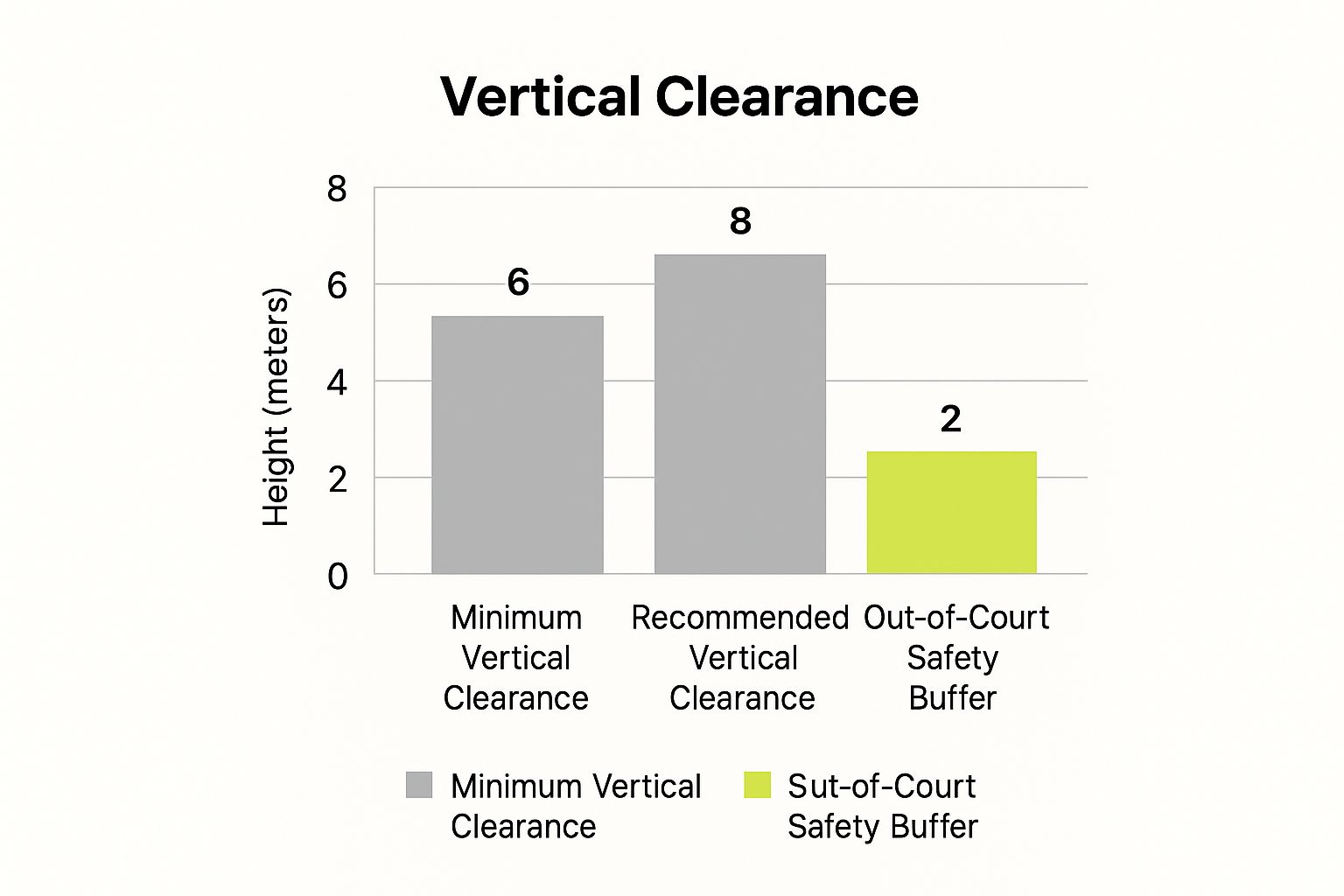
As you can see, the recommended ceiling height is quite a bit more than the bare minimum, which really drives home the point of planning for a higher level of play from the start.
One of the brilliant things about padel courts is how space-efficient they are. Their compact size is a huge advantage, allowing facilities to often fit multiple courts into the same footprint as a single tennis court. This is a game-changer for maximizing land use in clubs or urban areas.
Of course, all these extra space requirements mean nothing if the ground underneath isn't solid. Investing in proper site preparation is the absolute foundation for a court that's not only safe but will last for years to come.
Comparing Padel and Tennis Court Dimensions
To really get a feel for a padel court, the best way to understand its scale is to put it side-by-side with a standard tennis court. Sure, both sports have nets, racquets, and intense volleys, but the dimensions of their playing areas tell completely different stories. A quick look at the numbers shows just how different they are in both size and design.
A regulation tennis court for doubles play is a massive 23.77 meters (78 feet) long by 10.97 meters (36 feet) wide. That gives players a huge playing area of about 260 square meters.
Now, compare that to a padel court, which is a much cozier 20 meters by 10 meters, for a total of just 200 square meters. This isn't just a small tweak; it’s a core difference that completely shapes the game.
Why Size Matters in Gameplay
This massive size reduction has a huge impact on how padel is played. The smaller court naturally forces players closer together, which encourages lightning-fast reflexes and constant communication—it’s a big reason why doubles is the only way to play. The glass walls, which don't exist in tennis, shrink the playable space even more and demand an entirely different strategic approach.
The compact size of a padel court is one of the biggest reasons for the sport's explosive growth. It’s not just about the gameplay; it’s about pure practicality. You can often fit three padel courts into the space needed for a single tennis court, making it a much smarter use of land for clubs and sports facilities.
This efficiency is key to making the sport so accessible. More courts mean more playing time is available, lowering the barrier for new players who just want to give it a try. To dive deeper into how these differences change the on-court experience, check out our full article on the padel vs tennis debate.
Here’s a simple table to break down the key differences at a glance:
Padel Court vs Tennis Court a Side-by-Side Comparison
| Feature | Padel Court | Tennis Court (Doubles) |
|---|---|---|
| Length | 20 meters (65.6 ft) | 23.77 meters (78 ft) |
| Width | 10 meters (32.8 ft) | 10.97 meters (36 ft) |
| Total Area | 200 sq. meters | 260.76 sq. meters |
| Key Feature | Enclosed by walls | Open playing area |
Ultimately, a tennis court is a sprawling battlefield built for powerful serves and long, running rallies. The padel court, on the other hand, is a tight-knit arena designed for quick-fire shots, clever wall plays, and a much more social, high-energy vibe.
Common Questions About Paddle Ball Court Size
Now that we've nailed down the official dimensions and markings, let's tackle some of the most common questions people ask. Whether you're a player trying to settle a debate, a club owner planning an expansion, or just curious about the details, these quick answers should clear things up.
What Is the Minimum Ceiling Height for an Indoor Paddle Ball Court?
When you take the game indoors, the ceiling becomes just as important as the floor. The absolute bare minimum free height you need is 6 meters (about 20 feet) across the entire court. Anything less than that, and you'll find lobs constantly getting cut short by the roof.
However, if you're building a new facility today, you should aim higher. The International Padel Federation (FIP) strongly recommends a clearance of at least 8 meters (roughly 26 feet). This extra space is a game-changer, allowing for those high, looping defensive shots without a second thought. It also gives you much better options for installing pro-level, anti-glare lighting.
Can You Build a Non-Regulation Padel Court for Fun?
You could, but you probably shouldn't. While nothing is stopping you from building a custom-sized court in your backyard for a bit of fun, it really changes the game. The magic of padel is deeply tied to its official 20m x 10m dimensions.
The specific size of the court dictates everything—how the ball bounces off the glass, where players instinctively position themselves, and the whole strategic flow of a rally. Playing on an odd-sized court won't feel like real padel and won't prepare you for a match on a regulation court.
How Much Total Land Area Is Needed to Build a Single Padel Court?
The court itself covers 200 square meters (20m x 10m), but that's just the playing surface. You have to factor in the footprint of the steel structure, the foundations for the glass panels, and a safe amount of space around the outside.
A good rule of thumb is to budget for an area of about 22 meters by 12 meters. That gives you a total footprint of 264 square meters (or around 2,840 square feet). This provides enough room for the structure and a necessary safety buffer for players entering and exiting, or for those epic "por tres" smashes where a player has to run outside the court to keep the point alive.
Are There Different Court Sizes for Singles and Doubles Padel?
Nope! Unlike tennis, the padel court is one-size-fits-all. The official 20m x 10m court is used for both singles and doubles play.
It's worth mentioning, though, that padel was born to be a doubles game. The court's layout, the net height, and the angles of the walls are all perfectly tuned for the fast-paced, strategic dance of a four-player match. While playing singles can be an incredible workout, the court truly comes alive when it's two against two.
At Padel Rumors, our passion is giving you the most accurate and practical info to help you fall in love with this amazing sport. Whether you're just learning the rules or planning a build, we're here to help. Check out all our expert guides and the latest news at https://www.padelrumors.com.


